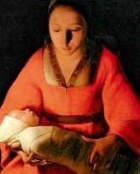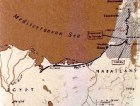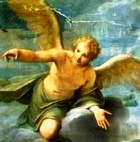Danger: Jesus’ parents flee to Egypt
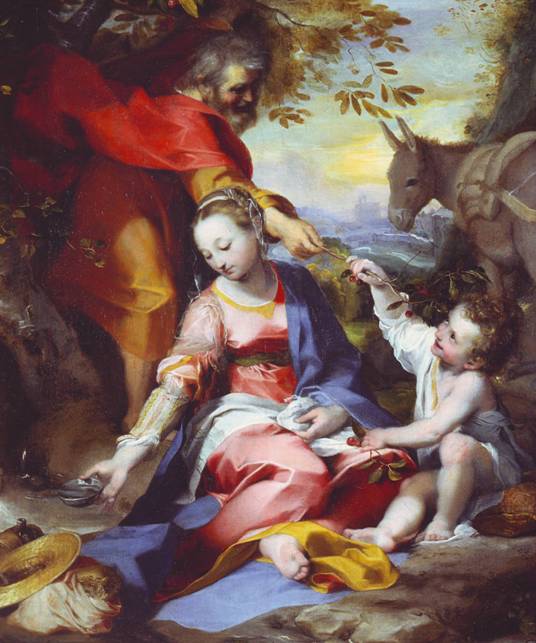
I just found this and had to share: Rest on the Return from Egypt, by Barocci. Who could resist the cheeky smile on Jesus’ face as he plays tug-o-war with a laughing Joseph. Even the donkey is smiling at this homely scene…
Questions for Bible study groups
- What do the gospel writers mean when they talk about an ‘angel’?
- What was the Slaughter of the Innocents, and why did it happen?
- How did Mary and Joseph save their little son Jesus from brutal death?
Joseph received a message from God that Mary’s son was in danger. He swiftly responded, taking his little family to the safe haven of Egypt – reversing the Exodus story of the Hebrew flight from the Egyptian Pharaoh.
The Angel’s message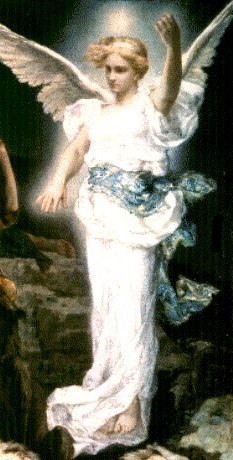
Yes, the picture of the angel (at right) is beautiful, but it is not what the gospels meant when they talked about an ‘angel’.
The writers of the gospel wanted to convey the idea that a human person under special circumstances was able to receive a direct message from God. The message could come in a dream, in a trance, or even in everyday life. But the person who received this message had a feeling of such strong certainty that they knew that what they were experiencing was a message from God. They were absolutely sure that something was going to happen (or could, with their consent).
This is what Joseph experienced soon after the birth of Jesus.
- He knew with utter conviction that Herod was about to launch an attack that could result in the death of the baby Jesus.
- He knew the only way to avoid this danger was to gather up his little family and run – to somewhere a long way away.
Don’t discount the possibility that part of his conviction may have been based on tangible information. Remember that Joseph and Mary were still in Bethlehem (close to Jerusalem, the centre of Herod’s power) and probably still in contact with Zechariah and Elizabeth (who might have had some access to high-level political information).
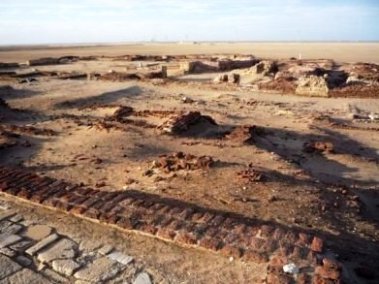 Nevertheless sudden flight with a young baby was, at best, eccentric. It must have seemed strange, almost demented. Joseph’s extended family would certainly have raised objections. But the dream/angel/information had convinced him of the gravity of the situation, and it seemed to him there was no alternative.
Nevertheless sudden flight with a young baby was, at best, eccentric. It must have seemed strange, almost demented. Joseph’s extended family would certainly have raised objections. But the dream/angel/information had convinced him of the gravity of the situation, and it seemed to him there was no alternative.
The place he chose to go was Egypt – an ironic choice in the circumstances. In the Genesis story, Egypt was the place of danger from which the Hebrews fled. Now it became a sanctuary for Jesus and his parents.
See a detailed map of the route Joseph and Mary may have taken at The Flight into Egypt. Above right is a photograph of the ruins of ancient Pelusium, through which Joseph and Mary almost certainly passed on their way to Egypt.
Read the blue text at the bottom of page
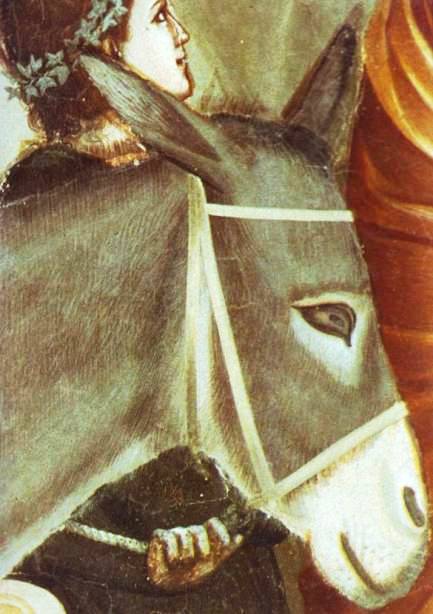
Giotto’s good-humoured donkey, detail from The Flight into Egypt, see end of page
The slaughter of the Innocents
What Joseph had feared would happen, did. There was a pogrom of all male babies under the age of two.
The instigator of this massacre was King Herod, the brilliant, paranoid madman who ruled Judea at this time. He was convinced that virtually everyone in his kingdom wished him dead, and he was right. He was universally hated, and for good reason. Among other things, he strangled his beautiful and popular young wife, a royal princess of the Jewish Hasmonean dynasty, and their two handsome young sons. He also murdered his wife’s mother and younger brother.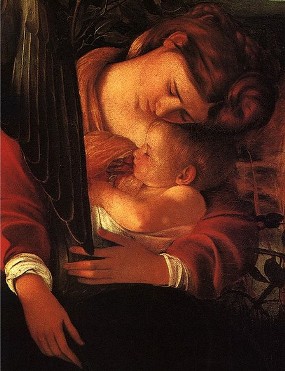
There is no record of the deed, but why would there be? There would have been less than fifty children who were murdered in the Slaughter of the Innocents, and they were peasant children, so it is not surprising that it goes unmentioned in official histories.
What is interesting, though, is the parallel this action has with the story of Pharaoh in Exodus 1:15-22 (where Pharaoh orders the midwives to murder male Hebrew babies), and the comparison of Jesus with Moses, who also was saved from wholesale slaughter.
At this point in the story, the gospel writer Matthew mentions the great Jewish matriarch Rachel. Her tomb is at Ramah, about five miles north of Jerusalem. It was near the road the Israelites took on their way to exile in Babylon. She is said to have died in childbirth on the way to Ephrath (Bethlehem).
Read the green text at end of page
Joseph returns with Jesus and Mary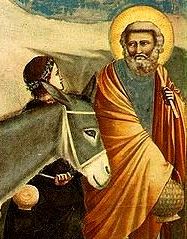
King Herod the Great died in about 4BC. His sons succeeded to his territories, but they were not given the title of ‘King’, something that rankled with them. For a time there was wrangling about which of King Herod’s remaining sons, the ones he had not killed, would succeed him.
Now that the great people of the land were engrossed in political manoeuvring, it was safe for the little family of Joseph, Mary and Jesus to return home.
They decided to live in the town of Nazareth, far enough from Jerusalem to make it a safe haven.
Read the red text at end of page
What happened next? See The Lost Boy
What the Gospels say
1. The Angle’s message. Read the blue text
2. The slaughter of the Innocents. Read the green text
3. Joseph returns with Jesus and Mary. Read the red text
Matthew 2:13-21 13 Now when they had departed, behold, an angel of the Lord appeared to Joseph in a dream and said, “Rise, take the child and his mother, and flee to Egypt, and remain there till I tell you; for Herod is about to search for the child, to destroy him.” 14 And he rose and took the child and his mother by night, and departed to Egypt, 15 and remained there until the death of Herod. This was to fulfil what the Lord had spoken by the prophet, “Out of Egypt have I called my son.”
16 Then Herod, when he saw that he had been tricked by the wise men, was in a furious rage, and he sent and killed all the male children in Bethlehem and in all that region who were two years old or under, according to the time which he had ascertained from the wise men. 17 Then was fulfilled what was spoken by the prophet Jeremiah: 18 “A voice was heard in Ramah, wailing and loud lamentation, Rachel weeping for her children; she refused to be consoled, because they were no more.”
19 But when Herod died, behold, an angel of the Lord appeared in a dream to Joseph in Egypt, saying, 20 “Rise, take the child and his mother, and go to the land of Israel, for those who sought the child’s life are dead.” 21 And he rose and took the child and his mother, and went to the land of Israel.
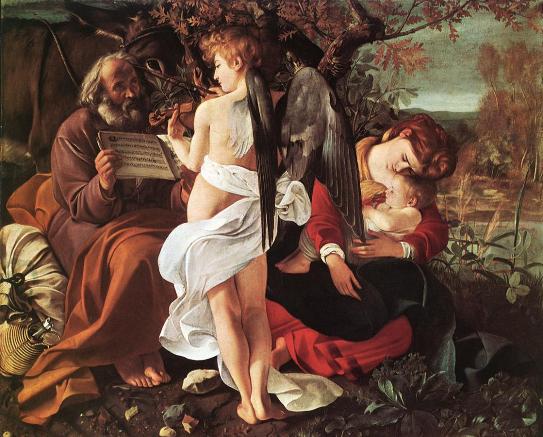
Rest on the Flight to Egypt, Caravaggio
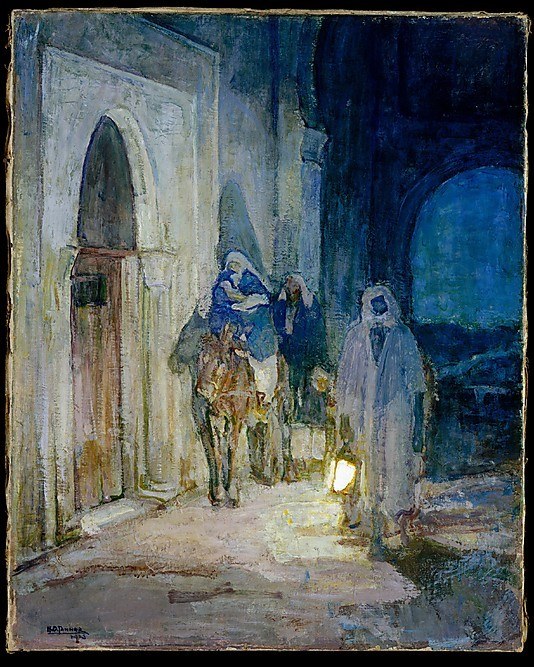
Flight into Egypt, Henry Ossawa Tanner, 1923
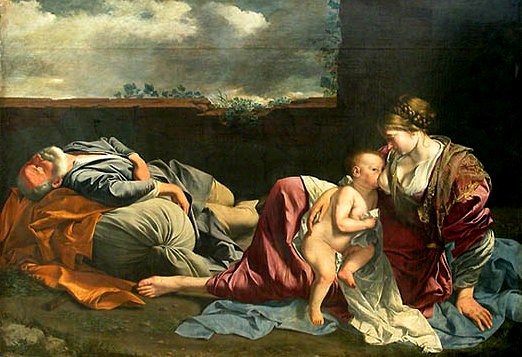
Flight into Egypt, Orazio Gentileschi
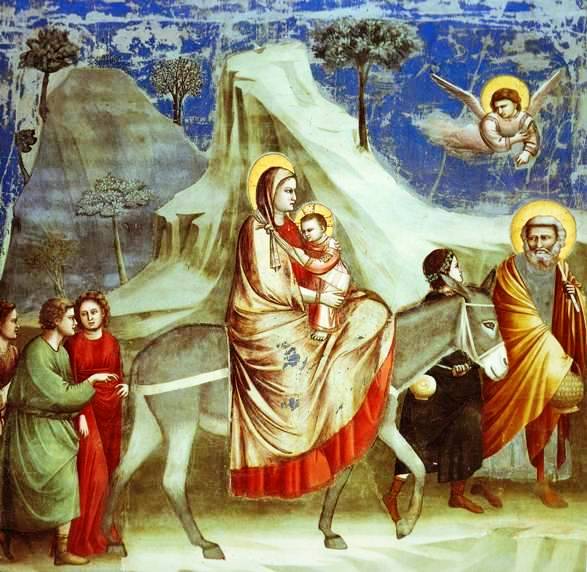
Giotto, The Flight into Egypt
You might like to compare the parallel accounts of the births of Jesus and John the Baptist in Luke’s gospel. You can find the gospel texts at http://www.womeninthebible.net/Elizabeth_bible_text.htm
Notice especially statements about
the pregnancy reaching term, Luke 1.57 and 2.6
the birth statement, Luke 1.57 and 2.7
marvelling onlookers, Luke 1.63 and 2.18
the taking to heart of what had happened, Luke 1.66 and 2.19
circumcision and name-giving, Luke 1.59 and 2.21
John’s birth is clearly a prelude to the birth of Jesus.

